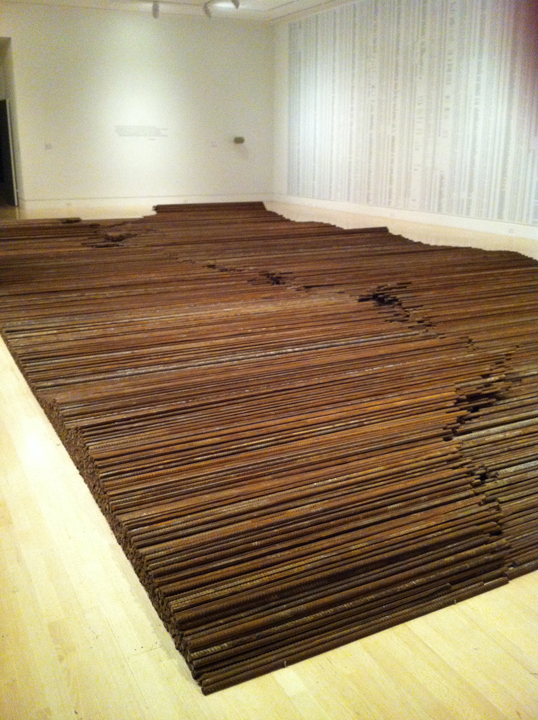A visit to the exhibit Ai Weiwei: According to What? at the Indianapolis Museum of Art
I first heard about Ai Weiwei and his work when a friend sent me a link to a video about his sunflower seed project created for the Tate Modern in London. The project involved 1,600 people from Jingdezhen, a town that is historically known for its porcelain production, who helped make and hand paint 100 million sunflower seeds (to scale). The sunflower seed is not only a political symbol in Chinese imagery, but it is also a very familiar item to many people. Made using traditional Chinese porcelain methods, these tiny handcrafted pieces ask the viewer to reconsider the all too familiar “Made in China” tag seen on many things we buy today. Contrary to our assumptions associated with items bearing that label, (cheaply made, mass produced, low quality) each seed has been given individual attention and care during production. A familiar item reproduced to an unimaginable quantity helps push aside any need for an understanding of art and emphasizes the message.
Impacted by Ai’s work, I kept my ears and eyes open for a chance to see it one day in person. My opportunity came when I heard that his show Ai Weiwei: According to What was coming to Indianapolis. I immediately found a time for it on my calendar.
Before going, I watched the documentary Ai Weiwei: Never Sorry. It is a more comprehensive look at his work than what I had found on my own and provides a great background for where it all comes from. The exhibit featured much of what was discussed in the documentary plus a few pieces I had not yet heard of.
An extremely powerful subject that has generated many pieces concerns the 2008 Sichuan earthquake that killed tens of thousands of people due to the shoddy construction of many government built buildings. The poor response to the natural disaster and the lack of building quality that were responsible for the tragic deaths of so many was infuriating to many Chinese people and parents. Furthermore, the information available to people who lost loved ones was kept secret. Ai has been collecting names of people who died, especially the children, by reaching out through twitter and various social media and posts everything he finds online.
 This piece titled Straight features piles of rebar that came from the buildings destroyed in the earthquake. The metal was collected in its tangled and twisted state, then painstakingly straightened by hand. The amount of work that it takes to straighten a piece of steel after it has been mangled is unreal. This was made clear by one of the videos playing in the gallery, which shows the making of Straight and a related piece called Forge. The floor is filled with this rusty landscape of metal while on the back wall is the list of the children killed. All the while, a recording of the children’s names being read out loud is playing. Because his camera is an extension of his eyes, he had footage from the earthquake for viewing as well.
This piece titled Straight features piles of rebar that came from the buildings destroyed in the earthquake. The metal was collected in its tangled and twisted state, then painstakingly straightened by hand. The amount of work that it takes to straighten a piece of steel after it has been mangled is unreal. This was made clear by one of the videos playing in the gallery, which shows the making of Straight and a related piece called Forge. The floor is filled with this rusty landscape of metal while on the back wall is the list of the children killed. All the while, a recording of the children’s names being read out loud is playing. Because his camera is an extension of his eyes, he had footage from the earthquake for viewing as well.
Awe inspiring and heart wrenching, Ai Weiwei considers his message within the context of the people that are involved. For me, his work demonstrates the effectiveness of using a single object repeated to generate powerful reactions. There is much to think about after leaving the exhibit…the sign of successful work.



